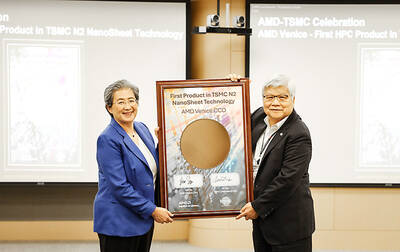There is nothing quite like a massive coal rail line to demonstrate China’s loyalty to the dirtiest of fossil fuels.
Almost a decade in the making, the nearly US$30 billion Haoji Railway is to start operations at the end of this month and eventually haul as much as 200 million tonnes from key producing regions in the north to consumers in the south.
That is more than Japan uses in a year and could cut China’s domestic seaborne coal trade by 10 percent in the long run, Fenwei Energy Information Services Co (汾渭能源信息服務) forecast.
In a world where governments and businesses are under pressure to leave the fossil fuel in the ground, the new rail is decidedly old-fashioned.
China has pumped more money into renewable energy than any other country and is battling pollution by urging its population to burn natural gas instead. Yet, it continues to mine and burn half the world’s coal.
“Coal will remain a dominant source of power in the next 10 years, even though it’s being gradually replaced by new energy,” Beijing-based Everbright Sun Hung Kai Co (大新鴻基) analyst Tian Miao (田苗) said.
One of the main reasons for building the nearly 2,000km railway is to ease transportation bottlenecks in the domestic supply chain. China is rich in coal — with its resource concentrated in northern Inner Mongolia and the provinces of Shanxi and Shaanxi — but the distribution is uneven.
The country is mainly served by trains hauling supply from the west to the east, including on the Daqin Railway. Coal is delivered to ports such as Qinhuangdao and Caofeidian before getting dispatched on ships to users in the south.
To improve the efficiency of north-south transportation, China approved the construction of the Haoji Railway (previously named Menghua) in 2012, about the time its growth in renewable energy sources accelerated.
The country’s longest coal line is to pass through Inner Mongolia and Shanxi, Shaanxi, Henan, Hubei, Hunan and Jiangxi provinces, helping to save time and costs of moving supply over vast distances.
“The project was mulled at a time when coal was facing serious rail bottlenecks,” Fenwei analyst Zeng Hao (曾浩) said. “Demand for rail capacity has eased with the rise of renewable energy and environmental pressure. The rail line has more significance today as a strategic transportation channel.”
The effects on top exporters such as Indonesia and Australia might also be muted, as overseas supply tends to be cheaper, Zeng said.
Imports account for less than 10 percent of China’s coal consumption.
China has made great strides in encouraging alternative fuels, adding the most solar and wind power capacity in the world and mandating minimum levels of green energy use.
However, coal still provides about 60 percent of its energy and it will take years to change that dependence.
The nation has also made energy security a priority amid a trade war with the US.
Haoji beginning operations is not in conflict with China’s broader energy goals, Huaxi Securities Co (華西證券) chief analyst Ding Yihong (丁一洪) said.
Coal plays a major role in securing the nation’s energy supply, while direct rail transportation is less polluting than diesel trucks, Ding said.
It takes about 20 days to deliver coal from Shaanxi to Hunan, Hubei and Jiangxi via the main seaborne route.
The new line could cut shipment time to just three days, Ding said.
Power plants would have more flexibility in managing inventories and responding to abrupt shifts in weather conditions, which could affect electricity use.
Those three southern provinces, which have some of the highest coal prices, would soon receive supply directly from low-cost regions.
“Cheaper supply will hit the market. Competition between coal producers will rise,” Ding said.
Total investment in Haoji has been estimated at 193 billion yuan (US$27.2 billion). Its shareholders include China State Railway Group Co Ltd (中國國家鐵路集團) and some of the country’s largest miners, such as China Shenhua Energy Co (神華能源), Inner Mongolia Yitai Coal Co (內蒙古伊泰煤炭) and China Coal Energy Co (中煤能源).
China State Railway Group did not respond to a fax seeking comment. Calls to the operator Mengxi Huazhong Railway Co were unanswered.
The rail line is to begin operations at about the end of this month, according to state-run Xinhua news agency, while the China Coal Transport and Distribution Association said that it would be on Tuesday.
The share of coal in China’s energy mix is falling, but consumption of the fuel would continue to rise, said Teng Suizhou, marketing director of Hubei Jingzhou Coal and Port Co, which is building storage and port facilities to serve the new line.
“For that reason, issues of rail delivery will need to be addressed,” Teng said.

TAKING STOCK: A Taiwanese cookware firm in Vietnam urged customers to assess inventory or place orders early so shipments can reach the US while tariffs are paused Taiwanese businesses in Vietnam are exploring alternatives after the White House imposed a 46 percent import duty on Vietnamese goods, following US President Donald Trump’s announcement of “reciprocal” tariffs on the US’ trading partners. Lo Shih-liang (羅世良), chairman of Brico Industry Co (裕茂工業), a Taiwanese company that manufactures cast iron cookware and stove components in Vietnam, said that more than 40 percent of his business was tied to the US market, describing the constant US policy shifts as an emotional roller coaster. “I work during the day and stay up all night watching the news. I’ve been following US news until 3am

UNCERTAINTY: Innolux activated a stringent supply chain management mechanism, as it did during the COVID-19 pandemic, to ensure optimal inventory levels for customers Flat-panel display makers AUO Corp (友達) and Innolux Corp (群創) yesterday said that about 12 to 20 percent of their display business is at risk of potential US tariffs and that they would relocate production or shipment destinations to mitigate the levies’ effects. US tariffs would have a direct impact of US$200 million on AUO’s revenue, company chairman Paul Peng (彭雙浪) told reporters on the sidelines of the Touch Taiwan trade show in Taipei yesterday. That would make up about 12 percent of the company’s overall revenue. To cope with the tariff uncertainty, AUO plans to allocate its production to manufacturing facilities in

Six years ago, LVMH’s billionaire CEO Bernard Arnault and US President Donald Trump cut the blue ribbon on a factory in rural Texas that would make designer handbags for Louis Vuitton, one of the world’s best-known luxury brands. However, since the high-profile opening, the factory has faced a host of problems limiting production, 11 former Louis Vuitton employees said. The site has consistently ranked among the worst-performing for Louis Vuitton globally, “significantly” underperforming other facilities, said three former Louis Vuitton workers and a senior industry source, who cited internal rankings shared with staff. The plant’s problems — which have not

COLLABORATION: Given Taiwan’s key position in global supply chains, the US firm is discussing strategies with local partners and clients to deal with global uncertainties Advanced Micro Devices Inc (AMD) yesterday said it is meeting with local ecosystem partners, including Taiwan Semiconductor Manufacturing Co (TSMC, 台積電), to discuss strategies, including long-term manufacturing, to navigate uncertainties such as US tariffs, as Taiwan occupies an important position in global supply chains. AMD chief executive officer Lisa Su (蘇姿丰) told reporters that Taiwan is an important part of the chip designer’s ecosystem and she is discussing with partners and customers in Taiwan to forge strong collaborations on different areas during this critical period. AMD has just become the first artificial-intelligence (AI) server chip customer of TSMC to utilize its advanced